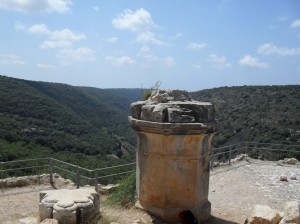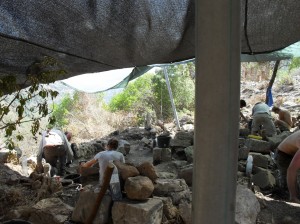I’ve just attended a conference that marked the end of a two-year project which investigated why the viking-age trading town of Hedeby on the south side of the Schlei fjord (on the boundary between Germany and Denmark) was deserted in favour of a town on the north of the fjord, Schleswig in the eleventh century. The picture shows the abandoned site of Hedeby in the foreground, enclosed by a great semicircular bank, with the medieval and modern town of Schleswig in the background.

The town of Hedeby in the foreground and Schleswig in the background
The research was funded by the German Volkswagen Foundation and much effort by the Schleswig-Holstein Landesmuseum went into making the excavations of the waterfronts and quays at Schleswig publicly available and also organised the scientific analysis of the metal and glass finds from both Schleswig and Hedeby.
The entire area of Hedeby is now owned by the Landesmuseum and the staff arranged a new metaldetecting survey of the intramural area in order to gain material from the latest time when the town was occupied. The latest levels had been disturbed by past ploughing and so the extent of eleventh-century occupation had previously been underestimated. A great quantity of metalwork was recovered and it now possible to say that Hedeby was abandoned after AD1020. Previously it was thought that the town declined in the 980s and that the move to Schleswig was more gradual.
The conference took place in the Landesmuseums’s headquarters in the Schloss Gottorf, a place which started as a moated medieval manor house of a bishop and was then turned into a huge mansion in the late seventeenth century. The space is vast for the display of exhibits (including a separate building for the Nydam boat, found in a nearby bog in the 1830s)
PhD students and staff from the museum and universities presented the impressive results from the project and there were also visiting lecturers who reported on current work on eleventh-century towns in Denmark, Norway, Sweden, Belgium, Germany, Poland, Russia and the UK. I was asked to provide an overview on the state of early medieval town studies in England.

Schloss Gottorf, Schleswig, headquarters of the Schleswig-Holstein Landesmuseum
The scientific analysis of the finds was particularly interesting and contributed much to our knowledge of trade through northern Europe, as shown for example by the changing sources of raw materials such as silver and lead. In the eleventh century most of the metals came from the Rhenish massif and emphasised the relations of Hedeby with the German kingdom.
While there was some similarities in the metalwork and glass from Hedeby and Schleswig, there were also significant differences: Hedeby’s copper alloys were more tin-rich than Schleswig’s which had more lead; while Hedeby’s glass contained a variety of constituents, that at Schleswig was all lead glass. And while there is much evidence for the casting of bronze at Hedeby, most of that material in Schleswig was in sheet form and must have been beaten into shape. All this has immense importance for our knowledge of medieval technologies, but the anomalies might also be explained by different people producing metalwork in the two places and could help explain why the town moved.
The most interesting ideas for the abandonment of Hedeby focussed on its highly congested and polluted condition, not only in the town itself but also in the harbour which had become choked with wrecks. But it is also possible that the idea of what a town should be like was changing. In the early eleventh century many towns were founded or redeveloped in the region – places such as Ribe, Roskilde (Denmark) and Lund (Sweden) – and of course Schleswig. These were founded by kings and bishops as their centres, and these had a different character and purpose from Hedeby.
I learned a lot from the presentations and the prolonged discussions and disagreements. And I was not the only one to benefit because in the following week I was including this new information in my lectures.
About today’s blogger:
 Professor Grenville Astill specialises in monasticism, industry, urban and rural settlement in medieval North Western Europe. He leads one of the longest running and most extensive research projects on a medieval monastery at Bordesley Abbey (http://www.reading.ac.uk/bordesley/) alongside a reconsideration of the process of medieval urbanisation. He has also conducted a research project in Brittany which tracks change in the countryside from the later Bronze Age to the 1920s using a combination of archaeological, documentary and building evidence.
Professor Grenville Astill specialises in monasticism, industry, urban and rural settlement in medieval North Western Europe. He leads one of the longest running and most extensive research projects on a medieval monastery at Bordesley Abbey (http://www.reading.ac.uk/bordesley/) alongside a reconsideration of the process of medieval urbanisation. He has also conducted a research project in Brittany which tracks change in the countryside from the later Bronze Age to the 1920s using a combination of archaeological, documentary and building evidence.











